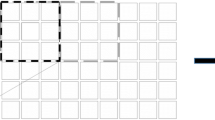Abstract
We are presenting comparative studies on two switched current (SI)differentiators; one is a classical version, the other is a cumulativeversion. Both are applied to smart pixel time-domain differentiation. Inboth differentiators, the differentiation is calculated by subtracting theinstantaneous photocurrent from a previously sampled one. The key issue inthis case is to obtain accuracy even with an extremely low current level(from pA to nA). The operability of both SI memories is verified throughchip tests. Within an optical input dynamic range of five decades and aminimum level of 2 Lux (1pA in current), the maximum current reproductionerror rate is 10% for the first one and 6% for the second.Furthermore, the cumulability of the second version is also confirmed by ourtests.
Similar content being viewed by others
References
P. J. Basel, “Active, Optical Range Imaging Sensor.”Machine Vision and Applications1(2), pp. 127–152.
Y. Ni and al., “An Analog Spot Position Coding Retina for Active Obstacle Detection.”International Journal of Robotics & Automation8(2), pp. 77–83, 1993.
S. J. Daubert, D. Vallanncourt, and Y. P. Tsividis, “Current copier cells.”Electronics Letters24(25), pp. 1560–1562, Dec. 1988.
G. Wegmann and E. Vittoz, “Analysis and Improvements of Accurate Dynamic Current Mirrors.”IEEE J. Solid-State Circuits25(3), pp. 699–706, June 1990.
C. Eichenberger and W. Guggenbuhl, “On charge Injection in Analog MOS Switches and Dummy Switch Compensation Techniques.”IEEE Trans. Circuits and Systems37(2), pp. 256–264, Feb. 1990.
S. Espejo, A. Rodriguez, R. Domonquez-Castro, and J. L. Huertas, “A Modified Dummy-switch Technique for Tunable Feedthrough Cancellation in Switched-current Circuits.” in Proceedings IEECIRC, Spain, 1993, pp. 270–273.
S. M. Sze, “Physics of Semiconductor Device.” Wiley-Interscience Publication, J. Willey & Sons, 1981.
E. A. Vittoz, “Analog VLSI Signal Processing: Why, Where and How.”J. of VLSI Signal Processing8, “Analog Integrated Circuits and Signal Processing.” pp. 27–44, July 1994.
R. J. V. Overstraeten, G. Declerck and G. L. Broux, “Inadquacy of the Classical Theory of the MOS Transistor Operating in Weak Inversion.”IEEE Trans. on Electron DevicesED-20(12) pp. 1150–1153, Dec. 1973.
R. R. Troutman, “Subthreshold Design Considerations for Insulated Gate Field-Effect transistors.”IEEE J. Solid-State Circuitspp. 55–60, April 1974.
Author information
Authors and Affiliations
Rights and permissions
About this article
Cite this article
Wang, C., Devos, F. & Ni, Y. A Comparison of Two Switched Current Differentiators at Extremely Low Current Level. Analog Integrated Circuits and Signal Processing 16, 35–45 (1998). https://doi.org/10.1023/A:1008217901525
Issue Date:
DOI: https://doi.org/10.1023/A:1008217901525




